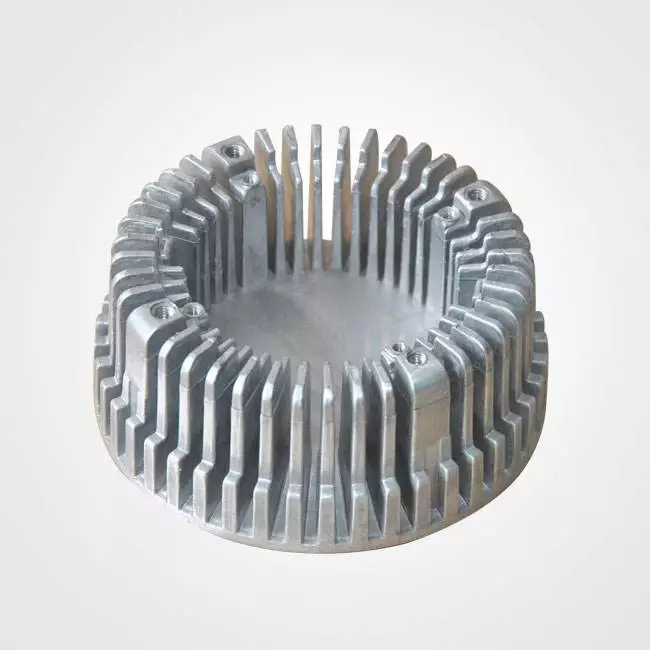Surface Treatments of Aluminum Alloy Die Casting Parts (Part One)
Features of aluminum alloy die casting parts
Aluminum alloys and aluminum have good plasticity and fluidity, and die casting processes are carried out in die casting machines with pressure; therefore, aluminum alloy die casts can be made with complicated shapes, good finishes and high accuracy. Given this factor, the need for the die cast being treated by the machining process is greatly reduced, which not only saves the electricity and the metal material, but also saves the labor cost. Aluminum and aluminum alloys have good thermal conductivity, which makes aluminum alloy die casting parts widely used for motor, automobile, motorcycle, oil pump, landscaping, electric power construction, precision instruments, transmission machinery, architectural decoration, internal combustion engine and other industries.
Aluminum alloy die casting parts have advantages over other die casting parts, advantages such as being beautiful and lightweight and corrosion resistant, which makes them in favour with people. Since the appearance of the automobile's lightweight, aluminum alloy has been widely used in the automobile industry. Aluminum alloy parts are more beautiful and are in more favour with customers after having surface treatments.
Surface treatments of aluminum alloy die casting parts can be divided into pre-treatments and post-treatments. Pre-treatments are to remove oxides and oil on surfaces of aluminum alloy die casting parts, to increase adhesion of post-treatments and to improve appearance of aluminum alloy die casting parts. The post-treatment of the aluminum alloy die casting product generally includes the powder spray, the stoving varnish, the oil injection, the oxidation, the sandblasting, the electroplating, etc., based on the different thickness and the finish of the die casting product's surface. The following is an introduction to the different surface treatment of the aluminum alloy die casting part.
1. The powder spray
The powder spray is a process that uses powder spraying equipment to spray powder paint on the surface of the workpiece; under the influence of static electricity, powder will be evenly adsorbed on the surface of the workpiece to form a powder coating; after being leveled and solidified through high temperature baking, powder coatings form different kinds of final coatings due to various types of powder paint. The powder spray process's effect in the mechanical strength, the adhesion, the corrosion resistance and the aging resistance is better than the painting process's; the cost of the powder spray process is lower than the cost of the painting process. The powder spray is generally classified into the outdoor powder spray and the indoor powder spray. The grain can be made to have the effect of the smooth surface and the sand surface.
Aluminum alloys and aluminum have good plasticity and fluidity, and die casting processes are carried out in die casting machines with pressure; therefore, aluminum alloy die casts can be made with complicated shapes, good finishes and high accuracy. Given this factor, the need for the die cast being treated by the machining process is greatly reduced, which not only saves the electricity and the metal material, but also saves the labor cost. Aluminum and aluminum alloys have good thermal conductivity, which makes aluminum alloy die casting parts widely used for motor, automobile, motorcycle, oil pump, landscaping, electric power construction, precision instruments, transmission machinery, architectural decoration, internal combustion engine and other industries.
Aluminum alloy die casting parts have advantages over other die casting parts, advantages such as being beautiful and lightweight and corrosion resistant, which makes them in favour with people. Since the appearance of the automobile's lightweight, aluminum alloy has been widely used in the automobile industry. Aluminum alloy parts are more beautiful and are in more favour with customers after having surface treatments.
Surface treatments of aluminum alloy die casting parts can be divided into pre-treatments and post-treatments. Pre-treatments are to remove oxides and oil on surfaces of aluminum alloy die casting parts, to increase adhesion of post-treatments and to improve appearance of aluminum alloy die casting parts. The post-treatment of the aluminum alloy die casting product generally includes the powder spray, the stoving varnish, the oil injection, the oxidation, the sandblasting, the electroplating, etc., based on the different thickness and the finish of the die casting product's surface. The following is an introduction to the different surface treatment of the aluminum alloy die casting part.
1. The powder spray
The powder spray is a process that uses powder spraying equipment to spray powder paint on the surface of the workpiece; under the influence of static electricity, powder will be evenly adsorbed on the surface of the workpiece to form a powder coating; after being leveled and solidified through high temperature baking, powder coatings form different kinds of final coatings due to various types of powder paint. The powder spray process's effect in the mechanical strength, the adhesion, the corrosion resistance and the aging resistance is better than the painting process's; the cost of the powder spray process is lower than the cost of the painting process. The powder spray is generally classified into the outdoor powder spray and the indoor powder spray. The grain can be made to have the effect of the smooth surface and the sand surface.

Related News
- Industrialization of the Composite 3D Printing for General Motors
- Porsche and GM Have Obtained Achievement in 3D Printing Auto Parts Technology
- Development of Aluminum Alloy Die Castings for Automobile Steering Knuckles (Part Two)
- Development of Aluminum Alloy Die Castings for Automobile Steering Knuckles (Part One)
- Die Casting Technologies of Automobile Structural Parts (Part Three)
- The Die Casting Technology of Automobile Structural Parts (Part Two)
- The Die Casting Technology of Automobile Structural Parts (Part One)
- Application of Heat-Free Aluminum Alloys to Integrated Die-Casting
- Mechanical Properties and Microstructure of Heat-Free Alloys
- Designing Die-Cast Molds for Complex Shells


